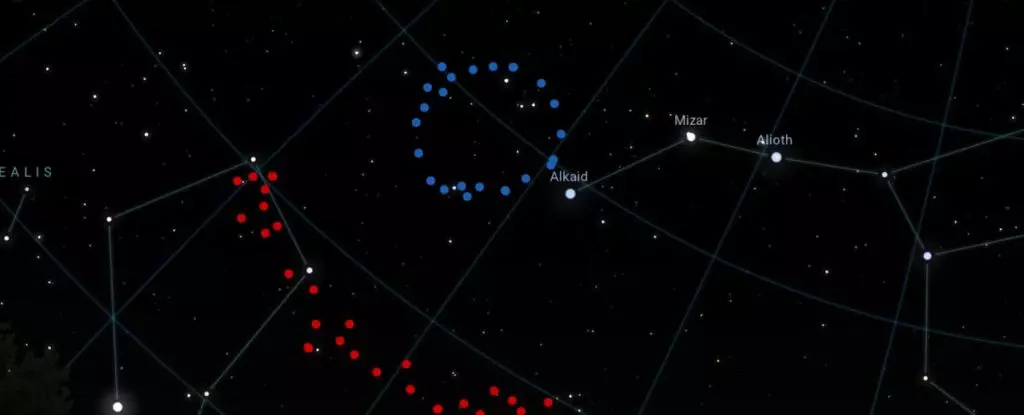The vastness of space often holds secrets that seem to defy our existing knowledge. A recent landmark discovery by astronomers, led by Alexia Lopez from the University of Central Lancashire, reveals an astronomical enigma: a gigantic ring of galaxies, dubbed “The Big Ring,” measuring a staggering 1.3 billion light-years in diameter. This revelation was unveiled at the 243rd meeting of the American Astronomical Society in 2024, accompanied by a publication in the Journal of Cosmology and Astroparticle Physics. While the sheer scale of The Big Ring is astounding, its existence presents profound questions about the very foundation of cosmology and forces us to reconsider how we interpret the universe’s composition and history.
Defying Expectations: Size and Structure
Typically, the consensus among cosmologists has been that substantial cosmic structures should not exceed a certain size. The theoretical limit has been calculated to be approximately 1.2 billion light-years. Therefore, The Big Ring, alongside another monumental formation known as the Giant Arc—discovered in 2021—calls these assumptions into question. The Giant Arc is already known to extend nearly three times that theoretical limit. The existence of these colossal formations suggests an urgent need to revisit the Cosmological Principle, which posits a homogeneous distribution of matter across the universe.
Lopez emphasizes the enormity of the situation by noting the implications both structures bring forth: “Neither of these ultra-large structures is easy to explain in our current understanding of the universe,” she stated. This highlights a scientific crossroads, one where our comprehension of cosmic structures and behaviors stands at odds with empirical observations— a friction that sparks compelling debates in the scientific community.
The Question of Cosmic Evolution
At the heart of this discussion lies the relevance of acoustic waves from the early universe, particularly Baryon Acoustic Oscillations (BAOs). Traditionally, these oscillations create spherical arrangements of galaxies across the universe, but The Big Ring does not conform to this model. While traditional BAOs maintain a consistent size, the corkscrew-like formation of The Big Ring suggests a more intricate cosmic tapestry. This raises existential questions: If these large-scale phenomena do not fit traditional categorizations, what does their existence mean for our broader understanding of cosmic evolution? Could we be venturing toward a paradigm shift in cosmology?
The prevailing models struggle to explain such puzzling revelations, revealing the limitations of our current framework. Theories by cosmologists like Roger Penrose have suggested cyclic models of the universe, wherein the cosmos undergoes endless cycles of expansion and contraction. However, such models are not devoid of complications. Could The Big Ring serve as evidence for a new, unconsidered phase of cosmic behavior?
Possible Explanations and the Road Ahead
Exploration into the nature of The Big Ring has led to the hypothesis of cosmic strings—fundamental topological defects in the fabric of space-time. These theoretical constructs could manifest as distortions that arose during the universe’s infancy. Although evidence for these cosmic strings remains elusive, their theoretical significance could bring a new dimension to our understanding of cosmic structures.
Still, skepticism looms large. It’s entirely plausible that The Big Ring and its cousin, The Giant Arc, could merely be exceptional alignments of galactic formations. The probability of such random arrangements, however, grows increasingly thin with further inspection and analysis. Lopez articulates this inconsistency aptly: “From current cosmological theories we didn’t think structures on this scale were possible.”
In this landscape of cosmic curiosity, the search for additional colossal structures across the universe becomes paramount. Their potential existence could shed light on immense cosmic phenomena and contribute crucial pieces to our knowledge puzzle.
Why We Must Embrace the Unknown
As we delve deeper into the cosmos, we must embrace uncertainty and the possibility that our current scientific frameworks may not capture the entirety of the universe’s complexity. The investigation of The Big Ring is not merely an endeavor in data collection; it embodies the quintessence of scientific inquiry. Rather than allowing our preconceptions to confine our ambitions, scientists must remain open to new discoveries that may unravel the fabric of our understanding.
The challenges presented by The Big Ring and the Giant Arc urge the scientific community to engage in profound discussions that may ultimately reshape our conception of the universe. In doing so, we must remember that the universe is dynamic, filled with phenomena that can alter the very theories that guide our understanding of existence. We stand on the precipice of a deeper cosmic revelation that beckons us to reconsider the universe’s narrative—one that continues to unfold, exponentially gathering complexity and wonder.

